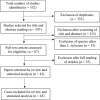Review and statistical analysis of clinical management of feline leishmaniosis caused by Leishmania infantum
- PMID: 35818075
- PMCID: PMC9272864
- DOI: 10.1186/s13071-022-05369-6
Review and statistical analysis of clinical management of feline leishmaniosis caused by Leishmania infantum
Abstract
Background: There is limited information about feline leishmaniosis (FeL) management in clinical practice. Leishmania infantum is the species of Leishmania most frequently reported in both dogs and cats in countries of the Mediterranean region (henceforth 'Mediterranean countries'), Central and South America, and Iran. This study was conducted to provide veterinary clinicians with an updated overview of evidence-based information on leishmaniosis in cats.
Methods: A review was performed using PubMed, Science Direct, Google Scholar and Web of Science. Case reports of FeL caused by L. infantum were sought for the period 1912 to 1 June 2021.
Results: Sixty-three case reports are included in this review. Fifty-nine out of the 63 cats were from Europe, mostly from Mediterranean countries (88.9%). Most of them were domestic short-haired cats (90%) with a mean age of 7.9 years, and had access to the outdoors (77.3%). Sixty-six percent of the cats had comorbidities, of which feline immunodeficiency virus infection was the most frequent (37.7%). Dermatological lesions (69.8%) was the most frequent clinical sign, and hyperproteinemia (46.3%) the most frequent clinicopathological abnormality. Serology was the most performed diagnostic method (76.2%) and was positive for 93.7% of cats. Medical treatment was applied in 71.4% of cats, and allopurinol was the most used drug (74.4%). Survival time was greater for treated cats (520 days; 71.4% of cats) than non-treated cats (210 days; 25.4%).
Conclusions: The majority of the cats had comorbidities, of which feline immunodeficiency virus was the most frequent. Dermatological lesions were frequently reported, and systemic clinical signs and clinicopathological abnormalities were also common. Serology may be useful for the diagnosis of FeL in clinical practice, and a positive titer of ≥ 1/40 may be a useful cut-off for sick cats. The reported treatments and dosages varied, but there was a good clinical response and longer survival in most of the cats treated with allopurinol monotherapy.
Keywords: Allopurinol; Cats; Leishmaniasis; Practitioners; Serology.
© 2022. The Author(s).
Conflict of interest statement
The authors declare that they have no competing interests.
Figures


Similar articles
-
Feline leishmaniosis in the Mediterranean Basin: a multicenter study.Parasit Vectors. 2024 Aug 19;17(1):346. doi: 10.1186/s13071-024-06419-x. Parasit Vectors. 2024. PMID: 39160611 Free PMC article.
-
Feline leishmaniosis: Is the cat a small dog?Vet Parasitol. 2018 Feb 15;251:131-137. doi: 10.1016/j.vetpar.2018.01.012. Epub 2018 Feb 2. Vet Parasitol. 2018. PMID: 29426470 Free PMC article. Review.
-
LeishVet update and recommendations on feline leishmaniosis.Parasit Vectors. 2015 Jun 4;8:302. doi: 10.1186/s13071-015-0909-z. Parasit Vectors. 2015. PMID: 26041555 Free PMC article. Review.
-
Treatment and long-term follow-up of a cat with leishmaniosis.Parasit Vectors. 2019 Mar 26;12(1):121. doi: 10.1186/s13071-019-3388-9. Parasit Vectors. 2019. PMID: 30909954 Free PMC article.
-
Leishmaniosis of companion animals in Europe: an update.Vet Parasitol. 2015 Feb 28;208(1-2):35-47. doi: 10.1016/j.vetpar.2014.12.023. Epub 2014 Dec 23. Vet Parasitol. 2015. PMID: 25573248
Cited by
-
Exploring Emerging Challenges: Survey on Phlebotomine Sand Flies and Leishmania infantum at the Northern Endemic Border in Europe.Pathogens. 2024 Dec 7;13(12):1074. doi: 10.3390/pathogens13121074. Pathogens. 2024. PMID: 39770334 Free PMC article.
-
Leishmania Seroprevalence in Dogs: Comparing Shelter and Domestic Communities.Animals (Basel). 2023 Jul 19;13(14):2352. doi: 10.3390/ani13142352. Animals (Basel). 2023. PMID: 37508129 Free PMC article.
-
Feline leishmaniosis in the Mediterranean Basin: a multicenter study.Parasit Vectors. 2024 Aug 19;17(1):346. doi: 10.1186/s13071-024-06419-x. Parasit Vectors. 2024. PMID: 39160611 Free PMC article.
-
Advancing diagnosis of feline Leishmania infantum infection through experimental insights.Sci Rep. 2025 Apr 10;15(1):12283. doi: 10.1038/s41598-025-96698-w. Sci Rep. 2025. PMID: 40210711 Free PMC article.
-
Assessment of the exposure to Phlebotomus perniciosus and the presence of anti-Leishmania infantum antibodies in stray cats in an endemic region of Spain, and their potential correlation with environmental factors.Vet Q. 2024 Dec;44(1):1-8. doi: 10.1080/01652176.2024.2421308. Epub 2024 Nov 7. Vet Q. 2024. PMID: 39508077 Free PMC article.
References
-
- Bezerra JAB, de IVPOliveira M, Yamakawa AC, Nilsson MG, Tomaz KLR, de Oliveira KDS, et al. Serological and molecular investigation of Leishmania spp. infection in cats from an area endemic for canine and human leishmaniasis in Northeast Brazil. Rev Bras Parasitol Vet. 2019;28:790–6. doi: 10.1590/s1984-29612019082. - DOI - PubMed
Publication types
MeSH terms
Substances
LinkOut - more resources
Full Text Sources
Medical
Miscellaneous

